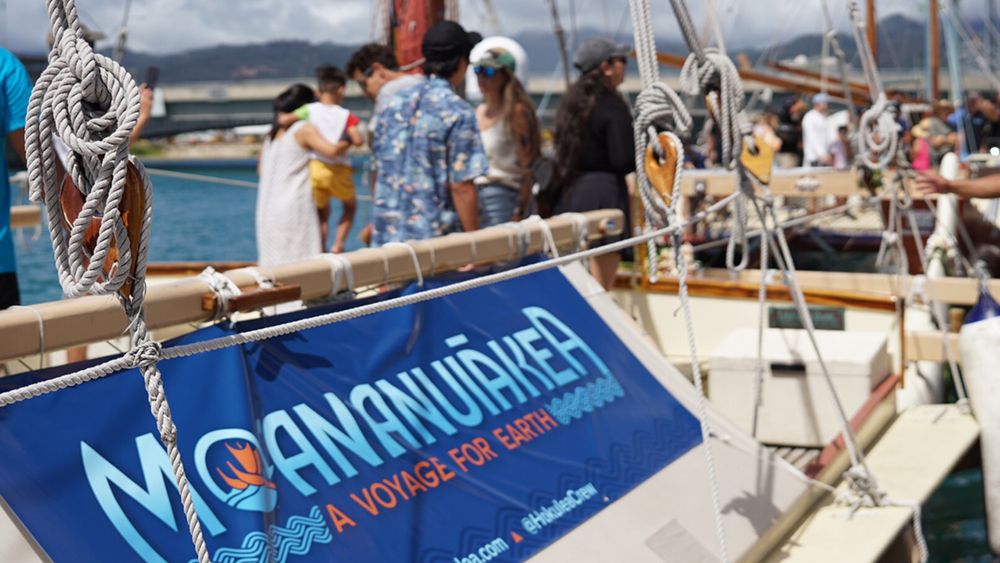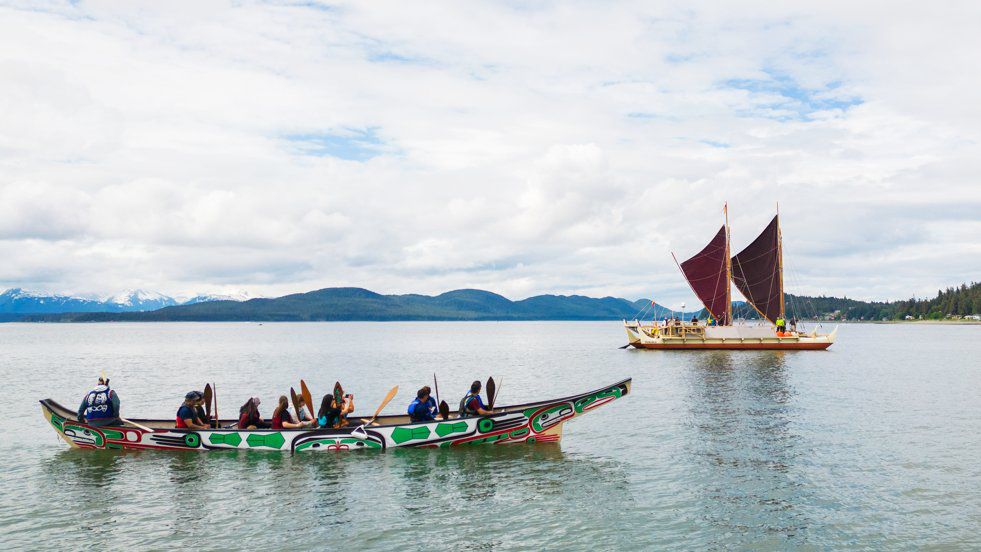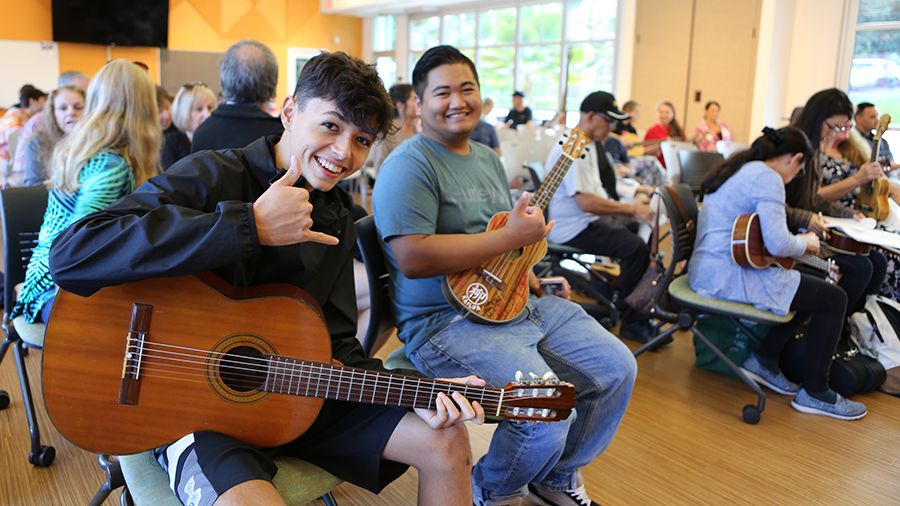HONOLULU — Well-wishers, along with Gov. Josh Green, Polynesian Voyaging Society CEO Nainoa Thompson, Pwo navigator Bruce Blankenfeld, crew members and supporters gathered on Sand Island on Saturday to wish Hokulea a safe journey with the sounding of the pu (the blowing of the conch shell), oli (chant) and pule (prayer).
It was a day to connect as crew members from previous voyages came to bid farewell to Hokulea and shared their stories. People of all ages asked questions of crew members such as how do you get fresh water to how do you find the North Star, and individual crew members shared personal experiences with guests who had the opportunity to board Hokulea and Hikianalia.
Together with his family, Gov. Josh Green offered a lei to Hokulea and talked story with crew members past and present.
“We must support Hokulea,” Gov. Green said, addressing the crowd. “For 50 years now, Hokulea has been a symbol or our cultural pride, our values. It is what can bring us together. That, I think, is what we should remember. Hokulea can bring us together in ways that I think almost nothing else can in our beautiful state.”
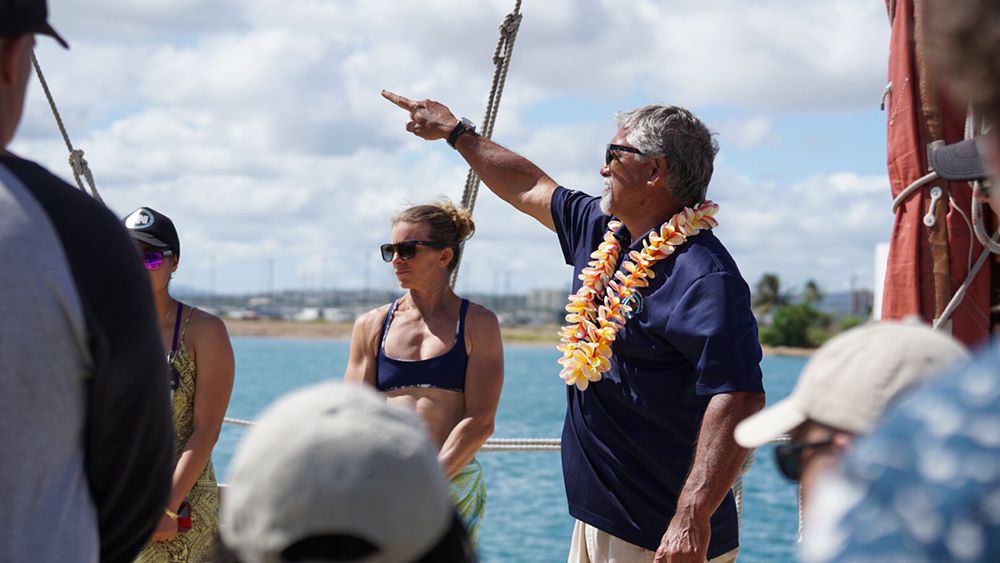
He said Hokulea and the journey that lies ahead is something everyone can reflect positively on. “It’s a time when we need to reflect together in this way.
“We’re lucky to have the Polynesian Voyaging Society perpetuating Hawaiian practices. Our culture is where our heart is. It’s probably why Hawaii is so extraordinary to most around the world. In a time when there is war, some are greedy, some fight, there’s conflict — this brings people together in the most extraordinary way,” said Gov. Green.
Nainoa Thompson also spoke to those gathered, sharing his reflections, concerns and hopes for the future.
He briefly noted the current world situation by saying, “I’m scared. It’s rough out there. When the storm comes, like Mau (Piailug, Micronesian navigator, who taught traditional, non-instrument wayfinding methods) said, ‘You put on the jacket, you face the wind, you stand there. And you don’t sit down till the storm leaves. And make sure your crew doesn’t know that you’re scared.’ Because he knew I was.”
During the Malama Honua worldwide voyage that was completed in 2017 (the global portion of the journey), Thompson said they learned an “infinite amount of stories” from the watersheds, coral reefs, from people in government, in classrooms at universities. He believes one key fact: “That all living systems on the Earth, all of them, will never be healthy unless the ocean is. The ocean is the driver of everything. Does climate matter? It controls it. Does food matter? It brings the most amount of food resources to humanity,” he said.
Thompson also spoke of the importance of taking action, of being involved, not just spectators, “to provide aloha and kindness to this earth.” After years of keeping Hokulea in home waters because of global concerns such as hurricanes, rogue waves in South Africa or violence in the Middle East, he said the concerns are still the same, even more so now than ever before.
He said it was a difficult decision to take Hokulea away from home, but added, “I’ll argue though we might leave this dock tomorrow, we’re not leaving home. We need to understand home is the Earth. And we all have kuleana to that Earth.”
In referring to Hokulea’s crew, he said, “These voyagers, they believe in something larger than ourselves. They believe in something that they can come together, they can do extraordinary things. They drive it by the values of aloha and love. They are extraordinary.”
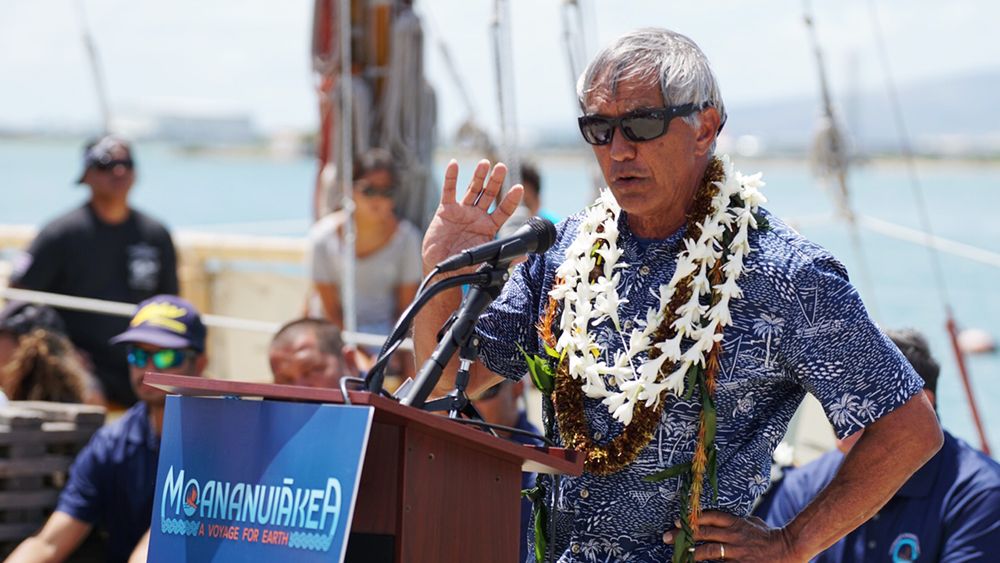
Thompson spoke of the upcoming generation as well. When Mau Piailug sailed Hokulea to Tahiti from Hawaii in 1976, it took 33 days, he said. When Thompson was at the helm, he said he “stumbled into” Tahiti in 34 days. On the Kealaikahiki Voyage — which set history with the first-ever woman navigator and captain on Hokulea, Lehua Kamalu at the helm, and a young crew — the voyage was completed in 17 days.
“What it really tells you is beating extinction is simple,” stated Thompson. “Make sure your students are better than you. The power of the navigator is not finding islands. The power of the navigator is the teacher who teaches young people to find their own islands for themselves by their own vision, their own values and their own beliefs.”
He later added, “What we need, governor, (is) when a storm comes and it’s only us 10 out there, there’ll be too many storms, they’ll be too exhausted. When the storm comes, what we need is Hawaii behind us. So when we look into the black of the storm, we see you,” speaking to everyone in attendance.
“I know that this crew and these canoes, they can do anything if we (all) come together,” said Thompson. “But this is not this crew’s canoes — this is your canoe. This is Hawaii’s canoe, all of Hawaii’s. If you’re with us, and I think you are, we will find the land we seek and we’ll come home.”
After five years of detailed planning and preparations, Hokulea will depart on Sunday, April 16 as she is transported via Matson to Juneau, Alaska. There, she will meet up with her escort boat, gear and supplies, then will head to Yakutat, Alaska, to start a pre-voyage “Heritage Sail” along the Southeastern coast.
On June 15, Hokulea will depart Juneau, launching the much-anticipated start of the Moananuiakea Voyage, “A Voyage for Earth.”
Stay up to date on Hokulea’s progress by following the journey on the Polynesian Voyage Society’s website.
Sarah Yamanaka covers events, environmental and community news for Spectrum News Hawaii. She can be reached at sarah.yamanaka@charter.com.





